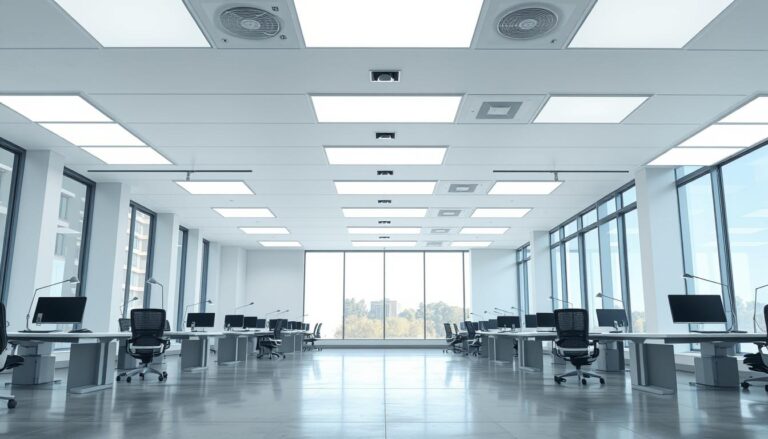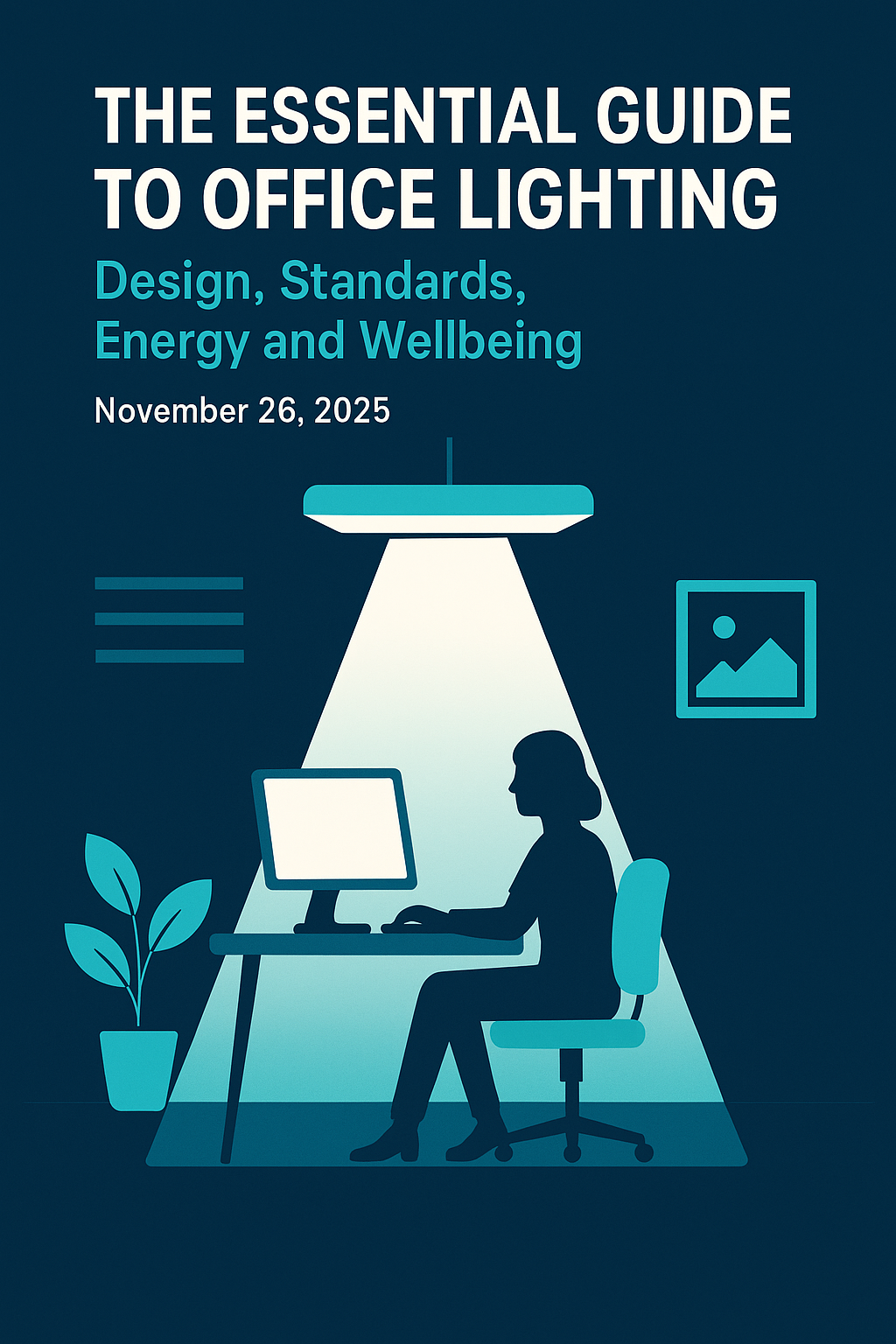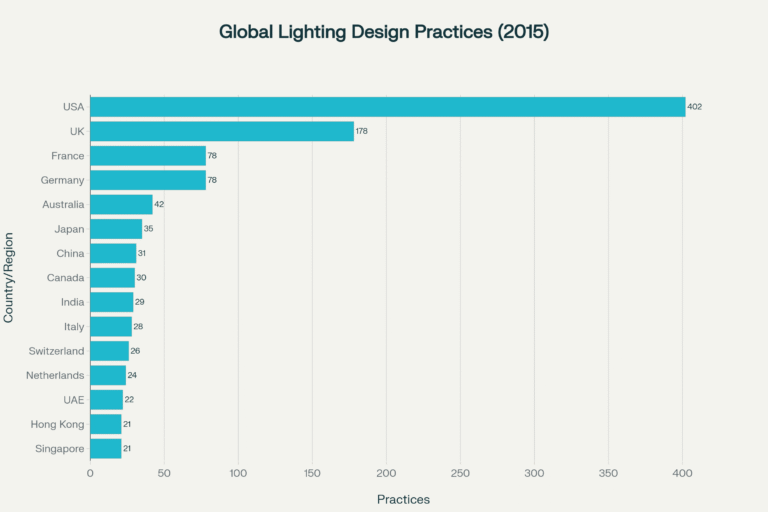CIBSE Recommended Lighting Levels
Lighting Level Finder 💡
Figures are recommended guidelines. Always confirm with a lighting designer or engineer.
| Category | Area / Space | Recommended Lighting Level (Lux) |
|---|---|---|
| Offices | General Office | 500 |
| Computer Workstations | 300–500 | |
| Filing Rooms | 300 | |
| Print Rooms | 300 | |
| Drawing Offices | 500 | |
| Drawing Boards | 750 | |
| CAD Design Areas | 300–500 | |
| Retail | Small Retail Outlets | 500 |
| Supermarkets | 750 | |
| Hypermarkets / DIY Superstores | 1000 | |
| Garden Centres | 500 | |
| Showrooms | 500–750 | |
| Industrial / Engineering | Tool Shops | 300–750 |
| Arc Welding | 300 | |
| Spot Welding | 500–1000 | |
| Heavy Machine Assembly | 300 | |
| Inspection and Testing | 500–2000 | |
| Engraving, Polishing | 750 | |
| Precision Work | 1000 | |
| Jewellery Manufacture | 1500 | |
| Aircraft Hangars (Maintenance) | 500–1500 | |
| Aircraft Hangars (Inspection) | 2000–5000 | |
| Workshops (Testing Area) | 1500 | |
| Food Production & Agriculture | Food Storage | 150–200 |
| Food Sorting / Preparation | 300 | |
| Critical Zones (Food Production) | 500 | |
| Colour Inspection (Food) | 1000 | |
| Livestock Buildings | 50 | |
| Sick Pens / Calving Stalls / Feed Preparation | 200 | |
| Cold Stores & Freezers | Cold Store Aisles | 100–200 |
| Cold Store Open Areas | 300 | |
| Freezer Aisles | 100–300 | |
| Freezer Open Areas | 300 | |
| Distribution & Storage | Loading Bays | 150–500 |
| Warehouse / Bulk Stores | 100 | |
| Packing & Dispatch | 300 | |
| Unpacking & Sorting Areas | 200 | |
| Large Item Stores | 100 | |
| Small Item Stores | 200 | |
| Trade Counters | 500 | |
| Banks & Building Societies | Counter Offices | 500 |
| Public Areas | 300 | |
| Staff Areas & Utilities | Changing Rooms & Toilets | 100–150 |
| Restaurants & Canteens | 200 | |
| Kitchens | Serving & Washing Up Areas | 300 |
| Food Preparation & Cooking Areas | 500 | |
| General Areas | Entrance Halls & Lobbies | 200 |
| Enquiry Desks | 500 | |
| Gatehouses | 200 | |
| Circulation Areas | Lifts | 100 |
| Corridors & Stairs | 100 | |
| Escalators / Conveyors | 150 | |
| Atria | 50–200 | |
| Atria with Plants | 500–3000 | |
| Entrances / Exits | 200 | |
| Communication / Service Areas | Switchboards | 300 |
| Post Rooms | 500 | |
| Building Services Areas | Boiler Rooms | 100 |
| Control Rooms | 300 | |
| Mechanical Plant Rooms | 150 | |
| Electrical Plant Rooms | 100 | |
| Places of Public Accessibility | Churches & Village Halls | 300 |
| Emergency Lighting | Escape Routes (Corridors) | 1–3 |
| Staircases | 3–5 | |
| Exit Signage & Critical Areas | 10 | |
| Healthcare (from CIBSE LG2) | Patient Rooms | 300–500 |
| Surgical Suites | 1000–3000 | |
| Hospital Corridors (Day) | 200 | |
| Hospital Corridors (Night) | 50 | |
| Cultural & Heritage Spaces | Works on Paper | 50–80 |
| Oil Paintings | 200–250 | |
| Sculptures | 200–300 | |
| Educational Facilities | Classrooms | 300–500 |
| Lecture Halls | 500 | |
| Display Screen Areas | Screen Workstations | 300–500 |
| Conservation-Critical Zones | Archival Storage | 50–100 |
Table 2. Emergency Lighting Levels
| Emergency Lighting Area | Recommended Level (Lux) | Notes |
|---|---|---|
| Escape Routes (Corridors) | 1–3 | Minimum illumination to safely guide occupants |
| Staircases | 3–5 | Enhanced lighting to clearly reveal steps |
| Exit Signage & Critical Areas | 10 | Ensures emergency signs and key points are visible |
Visit for more detailed information on emergency lighting levels.
Additional Guidance
Workplace Lighting Balance:
Modern guidance (as noted in the CIBSE Journal article) emphasizes balancing ambient and task lighting. For example, ambient office areas are typically maintained at 300–500 lux, while specific task areas (such as drafting or detailed workstations) may require 750 lux or more.Important Note:
These figures are recommended guidelines. Actual requirements may vary based on local standards, specific building use, and individual project needs. Always consult with a lighting designer or engineer to tailor solutions for your circumstances.
Interactive Lighting Tools
Specification for the 21st century
Find the Right Downlight Spotlight Batten Exit Sign Lightline Panel Bulkhead For Your Project 300% Faster
You can ask for anything, and it will search through every possible combination of products that match your specification.
Here are a few examples:
“Give me a downlight with an 80mm cut out”
“Match the attached spec with your products”
“I’m looking for a RAL9016 downlight that’s DALI dimmable”
It’s also trained on general international lighting standards and emergency lighting compliance.
Blog

EN 12464-1 Explained: Lighting Standards for Indoor Workplaces
EN 12464-1 explained: Understand the lighting standards for indoor workplaces with our comprehensive guide, covering requirements and benefits

The Essential Guide to Office Lighting: Design, Standards, Energy and Wellbeing
Good office lighting underpins almost every aspect of workplace design, yet it’s still one of the elements most often revisited late in a project. This

EN 1838 and EN 50172: Understanding Emergency Lighting Standards
EN 1838 explained: Understand emergency lighting standards and how to apply them. Practical advice for compliance with EN 1838 regulations.

The Growth of Lighting Design: How Light is Shaping the Future of Spaces in 2026
In 2026 lighting isn’t a finishing touch — it’s the thing that makes a space feel right (or terribly wrong). Designers are no longer asked just to make rooms bright; they’re expected to think about sleep cycles, desk-booking patterns, and the carbon cost of every fitting. The best lighting now works quietly in the background, nudging people into focus, rest or calm without anyone having to think about it.

The Fourth Dimension of Architecture: How Light Shapes Space and Emotion
Discover the Fourth Dimension of Architecture: our ultimate guide explores how lighting shapes space and emotion, enhancing architectural design

Lighting Ewaste Statistics in the UK
The UK is the second-largest producer of e-waste per capita globally, generating approximately 1.6 million tonnes of electronic waste annually. With an average of 24kg per person in 2022,